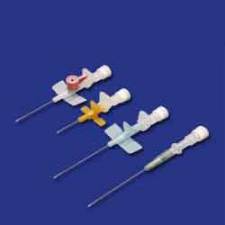by Mr Mike Yeats Derriford Hospital, Plymouth, UK.
Reproduced with permission from Update in Anaesthesia
Introduction
The first article in this series described the maintenance of a mercury sphygmomanometer, this article describes the maintenance of an aneroid blood pressure apparatus. Aneroid means, in Greek, operating without liquid or containing no fluid. Aneroid blood pressure gauges are generally smaller than mercury ones but they are easily damaged and can go out of calibration without detection.
 A common type of aneroid apparatus is shown in figure 1.
A common type of aneroid apparatus is shown in figure 1.
It consists of a dial which normally rises to 300mmHg and a thin brass corrugated bellows inside. There is a shaft which connects two pins at right angles to each other; one of these rests on the bellows, the other is inside a concave sided triangle which meshes with a pinion connected to the dial pointer.
A thin coiled spring (known as a hair spring) is also connected to the pinion and returns the pointer to zero when the pressure is released.
When in use the gauge is connected to a blood pressure cuff around the patient's arm. As the pressure in the cuff rises, the pin resting on the expanding bellows is lifted. This movement is transmitted by the other pin which moves the triangle and therefore the pinion and pointer. This can be seen in figure 2.

The following errors may occur:
Leaks in the system.
If a leak develops in the system wrap the cuff around itself and secure the end. Inflate the system to 250mmHg, watch the pointer. If it slowly drops there is a leak - it is most likely to be in the cuff or inflation bulb. It is fairly rare for a leak to occur in the gauge itself. A small pointed brush with soapy water on it will help find the smallest leak.
Incorrect zero - the gauge does not return to zero after the cuff has been deflated. On some models, such as the example photographed, there is an adjustment screw to set the zero point. However using this screw requires the instrument to be taken out of the case and the screw may be very stiff. The easiest method of adjusting the zero is by removing the glass from the front of the gauge and carefully taking off the pointer and replacing it in the correct position The pointer can usually be taken off using your finger and thumb nails. If this is not successful find two very small screwdrivers or thin flat pieces of metal and lever the pointer upwards using one on each side.
Calibration check. Every aneroid blood pressure gauge should be compared with a well maintained mercury sphygmomanometer on a regular basis. Connect the gauges together with a plastic T-piece and connect the third arm to an inflation bulb (figure 3).

Inflate the bulb slowly and note the readings showing on each instrument on a piece of paper at intervals of say, 20mmHg, starting at 40mmHg and going up to 200mmHg. After you have finished the test inspect the figures (example shown below) and note the difference between them. If the readings are within a few millimeters of mercury throughout the scale this is acceptable for clinical use.
In Table 1 the aneroid is reading 10mmHg higher across the scale - this is an example of a linear error.
Table 1: Example of a linear error
| Mercury Sphyg. (mmHg) | Aneroid Sphyg. (mmHg) | Difference (mmHg) |
|---|---|---|
| 40 | 50 | +10 |
| 60 | 70 | +10 |
| 80 | 90 | +10 |
| 100 | 110 | +10 |
| 120 | 130 | +10 |
In the example shown in Table 2, at low pressures the aneroid sphygmomanometer reads less than the mercury sphygmomanometer, becomes the same at 80mmHg, and then reads higher above 80mmHg. This is an example of a non-linear error.
Table 2: Example of a non-linear error
| Mercury Sphyg. (mmHg) | Aneroid Sphyg. (mmHg) | Difference (mmHg) |
|---|---|---|
| 40 | 20 | -20 |
| 60 | 50 | -10 |
| 80 | 80 | 0 |
| 100 | 110 | +10 |
| 120 | 140 | +20 |
Correction of calibration. This is required occasionally, usually as result of the gauge being dropped. It is best done by someone who has experience of aneroid blood pressure machines. However, it may be undertaken by carefully following the instructions below. Each adjustment should be made in very small amounts followed by a check to assess the effect.
- Start by making sure the pointer is on the zero mark.
- Remove the glass, then carefully remove the pointer and lift off the dial. You should now see the triangle with concave sides, on one side of which is a pin. In order to correct a non-linear error bend this pin very slightly away or towards the side of the triangle, replace the dial and pointer and run the calibration check again. Repeat this operation until the error has gone.
- When correcting a linear error bend this pin very slightly along the line of the triangle side. Run the calibration check again and keep adjusting until the error is gone.
- Broken cover glass. Visit the local watch repairer or make a glass from a thin plastic sheet.
After making the adjustments apply a little watch oil to the bearing points.
This article contained links to the following additional information:
Maintenance of a mercury sphygmomanometer
©World Federation of Societies of Anaesthesiologists








